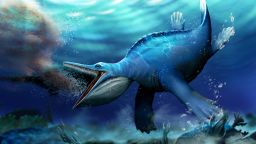Scientists have discovered a 246 million-year-old marine reptile fossil, the oldest of its kind to be found in the Southern Hemisphere, shining a new light on the early evolution of marine mammals.
The greatest mass extinction event in the fossil record – known as “The Great Dying” – occurred some 252 million years ago, wiping out some 95% of species on land and sea.
What followed was the emergence of new creatures that evolved from those that survived, including reptiles that evolved from living on land to living at sea.
Sauropterygians were ancient aquatic reptiles that existed for around 180 million years during the Mesozoic era, 251 to 66 million years ago.
Nothosaurs were a type of Sauropterygian that lived on Earth during the Triassic period, the first period of the age of dinosaurs, 251 million to 200 million years ago.
However, their early evolution had only been known from fossils found in the Northern Hemisphere, according to the study published in the journal Current Biology Monday.
Fossils of these animals have been commonly found in Europe, as well as southwest China and the Middle East, with some fragmentary occurrences in Wyoming in the United States and British Colombia in Canada, according to lead study author Benjamin Kear, a paleontologist at Uppsala University’s Museum of Evolution in Sweden.
“But it’s totally unexpected to find one at the other end of the Earth,” Kear told CNN Tuesday.
At the time nothosaurs existed, almost all of Earth’s landmasses were incorporated into one supercontinent known as Pangea. This supercontinent was shaped like a horseshoe and in the middle of it was the Paleo-Tethys Ocean where these animals were thought to live, according to Kear.
He said the big question was how these animals got from one side of the Earth to the other, since the other side was surrounded by a giant global ocean called Panthalassa, which stretched from pole to pole.
“This has never been explained, we don’t know what’s going on. All of a sudden, we find the nothosaur at the South Pole in New Zealand and, so, it’s kind of like upended everything,” Kear said.
A single nothosaur vertebra was found in a loose bolder along the Balmacaan Stream at the base of Mount Harper in New Zealand in 1978, according to a university press release. Many fossils are being found all the time, and this material was deposited in New Zealand’s National Paleontological Collection, Kear said. The now-late paleontologist Robert Ewan Fordyce alerted him to the find but the coronavirus pandemic delayed researchers travelling to look at it until last year.
It was only after an international team of paleontologists examined the vertebra and the fossils from the rocks surrounding it that they discovered that it pushed back the fossil record of sauropterygians in the Southern Hemisphere by more than 40 million years.
Kear said the age of the fossil is “really interesting” because it shows that “246 million years ago, which is very close to the dawn of the age of dinosaurs, that they basically adapted to life in the sea and… suddenly went global.”
The researchers said that the fossil provides that first evidence that early globalization was occurring at the same time that these reptiles were rising as oceanic predators and complex marine ecosystems were forming.
The study suggests these ancient marine reptiles were going around Earth’s poles, swimming all the way around the supercontinent as a continuous coastal highway, Kear said.
Nothosaurs had a slender body, long neck, long limbs and a tail. They would have paddled through water with their limbs. But over time, later sauropterygians developed better paddles.
Kear, who also works in Svalbard in the Norwegian Arctic, said researchers are planning to look for more fossils all over the world in an attempt to “track these stories from pole to pole” and understand how the animals were migrating around the supercontinent.
“What we’re looking at here is probably a story that goes beyond this super extinction event, goes deeper in time, and we can start to see that these animals were already adapting to life in the sea,” he said. “We’ll see, we’ll keep digging and see what we can find.”






